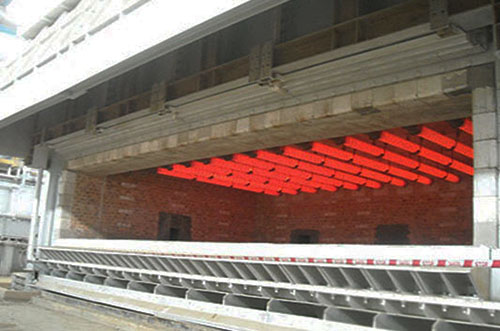Primary Al-Alloy Bulk Production by Retrofitting EMS on Furnace Wall: Part Two
by Dr Pradeep K. Maitra (former GM QA & Head R&D, BALCO) LM-IIM, Bhilai Chapter, India
Abstract
A key part of the aluminum alloy bulk production process is force stirring within holding furnace environment.
Magnetic force stirring is one such technique and this comprises two main constituents; the electromagnetic pump, and a permanent magnetic stirrer.
Force Stirring Device for HF
The HF consists of a steel box lined with alumina refractory brick, supported with hydraulic tilting mechanisms and metallic radiant electrical tube heater panels posted inside the roof of the furnace. The water cooled hydraulic door is operated for charging process scrap & raw materials, dross removal and mechanical stirring of the melt. The HF is equipped with launders for hot metal feedings and discharge ports for feeding continuous ingot casting machines in tandem. Due to this reason consistent quality of Al-cast alloys in small quantities are well produced in IF however the production & productivity being low its application for bulk alloy making is restricted. The HF (Figure 1) is a heated reservoir to hold molten metal preparatory to casting; it provides high efficiency, precise temperature control often used for melting new scraps.

Figure 1: Showing electrically heated melting/holding furnace
Solid-Al is considered as a good conductor of heat, but in fact the amount of heat conducted from the liquid-Al to the solid charge (scraps, alloying elements etc.) is very poor. For effective heat transfer from the liquid to the solid charge requires the convection mechanism by circulation of the liquid metal within the bath. Therefore in Al-alloy production, effective and reliable stirring of the melt is considered as one of the prerequisites for both production and productivity.
The objective of HF installation at the smelter cast house was to utilize the thermal energy of the hot metal (~900°C). However during metal tapping, transporting, pouring & holding the molten metal in furnace chamber, a certain amount of heat is lost through the furnace wall, floor, roof & door and the melt temperature drops. The roof top heaters transfer heat by both radiation & convection to the refractory lining and the bath surface the hot refractory then radiates more heat to the bath. However the temperature differences are generated between the bottom and surface of the molten metal due to the increase in metal depth and difference between the combustion chamber and the thermal leakages. But thermal losses are constant irrespective to the rate of casting, therefore, maximum thermal energy can be harnessed through rapid production, but this objective gets defeated during cast alloy production without force stirring.
From above discussions it is evident that without effective force stirring of Alloy melt, the chemistry consistency & energy efficiency can’t be achieved economically in HF.
Accordingly one HF (metal holding capacity-7m X 3.5m X 1m = 24.5m3) was suggested for modification.
Background of Magnetic Force Stirring
The slow stirring in HF is carried out by a multifunctional device called “Furnace Tending Machine” which is meant for skimming, cleaning and stirring the molten Al-alloy. Magnetic stirring systems are based on the principle of Magneto hydrodynamics (MHD) or study of fluid flow by magnetic field. This theory was conceptualized by Hanne’s Alfven. In other words magnetic fields can induce currents in a conductive fluid, which in turn creates forces on the fluid and also changes the magnetic field itself. Based on the above concept magnetic pumps & stirrers were developed.
i) The Electromagnetic Pump (EMP) was used in the 1960s to pump molten Na, and for Zn & Al in 1970s, and now for transporting molten metal for casting. Two different versions of EMP were produced; d.c. electromagnetic pump, & linear induction electromagnetic pump, which can be used for stirring the liquid metal by re-circulating the melt.
ii) The Permanent Magnetic Stirrer (PMS) an alternative to the mechanical pumps and EMS. Besides electromagnets US, Japan & China have developed PMS’s to run by a permanent magnet. EMS-system has higher electrical, running and maintenance costs in comparison to PMS, but it is not universally produced, & has a limited market share in Japan & China. Based on the above information on EMS, it was decided to locate the suitable producers of the equipment and create liaison with their marketing agencies to get familiarized with the machine and the process of its installation at cast house.
Find Instantly Thousands of Heat Treatment Diagrams!
Total Materia Horizon contains heat treatment details for hundreds of thousands of materials, hardenability diagrams, hardness tempering, TTT and CCT diagrams, and much more.

Get a FREE test account at Total Materia Horizon and join a community of over 500,000 users from more than 120 countries.